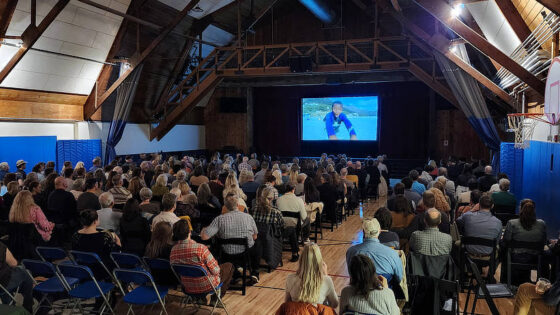Where the Wells Run Dry: Daniels Heads Kansas Project to Address Water Sustainability
By Diane Huskinson
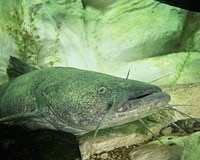
The Smoky Hill watershed, so named for the river that runs east from Colorado through Kansas, receives an exceptionally modest annual rainfall. In western Kansas, the average is between 16 and 24 inches. Counted among the Central Great Plains, the land is flat, dry, and expansive. During times of drought, deep-rooted native grasses once held the soil’s moisture, and river and wetland habitats were home to more than 40 species of fish, ranging from the endangered Topeka Shiner to abundant large flathead catfish and waterfowl.
But the landscape has changed. Since the advancement of the American frontier, prairie grasses and playa wetlands have been replaced — mostly by agriculture. And where rows of corn, wheat, and soybean sweep across fields as far as the eye can see, farmers are left vulnerable to the region’s volatile climatic whims.
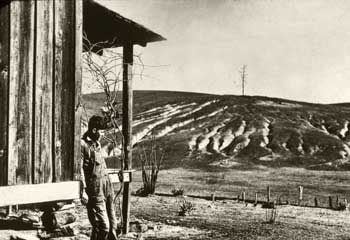
In the last 100 years, the Smoky Hill watershed has faced three of the worst droughts on record, including the Dust Bowl in the 1930s and the North American Drought of 1988. In the midst of yet another drought that took hold in 2012, many rural Kansas communities are becoming ghost towns as farmers abandon lands where the wells have simply run dry. Others are digging deeper wells, further depleting an already stressed system. But it’s boom or bust, and when it rains, it pours. If dusty topsoil isn’t blown away by semiarid winds, it’s washed into surface water supplies during infrequent flooding events. Climate change is happening, and the future of the region’s water supply is uncertain.
The Challenge

To predict the potential impact of climate variability, climate change, land use, and human activity on water resources in the Central Great Plains, Melinda Daniels, Ph.D., who joined the Stroud Center’s staff in May, is leading a three-year research project recently funded by the National Science Foundation.
Daniels and her team, to include a post-doc and seven collaborators*, will conduct field studies in the Smoky Hill watershed, and they’ll use the data they collect to develop a scientific model for their predictions. The model will help them identify the most effective strategies to achieve sustainability. Equipped with this knowledge, they’ll then make policy recommendations to state agencies and initiate community outreach.
“Unfortunately,” says Daniels, “current water use practices are not sustainable considering the extreme climate variability within this region.” And while agriculture is a relatively small contributor to the state’s economy, it is a huge part of the culture, she explains. Therefore, “the goal is to optimize economic and ecosystem sustainability. Where is that sweet spot between having enough water recharge to prevent an ecological catastrophe and maintaining the regional agricultural economy?”
Incentives might help strike a balance. Many farmers in the region are opting for center-pivot irrigation to water their crops. “That further removes water from the system for a very short-term benefit and virtually no long-term sustainability,” Daniels says. “Policy optimization would perhaps offer incentives to farmers who convert from cornfields or soybeans to pastureland with cattle. Pastures are much better able to sustain periods of drought.”
When it comes to community outreach, influencing the culture to make changes poses a challenge, but not an impossible one, according to Daniels: “Climate change is a tricky topic. In this area of the country, climate science and climate change are not as readily accepted as in other areas. However, as far as what’s driving climate change, in this case, it’s a moot point. We don’t need to agree that humans are inducing climate change to encourage more sustainable practices that maximize water quality and availability. Instead, we frame the discussion around natural climate variability. Farmers are risk averse, and they try to make decisions based on what the weather will be like next year. By appealing to those concerns and showing them it’s going to help them sustain their businesses, the opportunity for outreach is great.”
*Project Collaborators: Marcellus Caldas (KSU Geography), Aleksey Sheshukov (KSU Biological and Agricultural Engineering), Joeseph Aistrup (KSU Political Science), Jason Bergtold (KSU Agricultural Economics), Jessica Heir-Stamm (KSU Industrial Manufacturing and Systems Engineering), and Martha Mather and David Haukos, (both with USGS-USFWS Kansas Cooperative Unit).
Smooth Operations: Keeping Our Campus Running
Thanks to the skilled and experienced facilities management team, Stroud Water Research Center’s high-tech, environmentally sustainable campus runs like a well-oiled machine. Dave Funk, Will Milliken, Solomon Romero, Javier Tinoco, and Tonya Prigg, all working behind the scenes, maintain a space for our scientists and educators to do what they do best. Without their exceptional care of the Stroud Center’s buildings and grounds, our work would not be possible.
Meet the Team
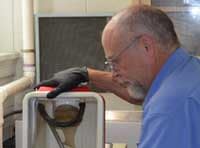
Dave Funk, director of facilities since 1996, has worked at the Stroud Center since 1976 as an entomologist and key member of our research team. His long tenure at the Stroud Center and his keen interest in mechanical operations have given him an exceptional understanding of how its physical plant operates. And his expertise is all the more valuable with the addition of our Moorhead Environmental Complex. LEED®-certified to the Platinum level, this green building for environmental education and public outreach utilizes rainwater capture, a wetland waste treatment system, and other complex systems like an upgraded geothermal heating and cooling system. Funk oversees all of these systems.
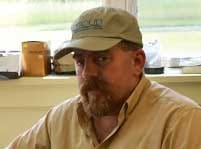
Likewise, Will Milliken, the Stroud Center’s maintenance mechanic since 2000, has developed a comprehensive understanding of its complex mechanical, plumbing, and electrical systems. He’s mastered systems that have been developed over the course of the Stroud Center campus’s 45-year history. He keeps our indoor stream flowing, manages our composting toilet system, and assists researchers in building new infrastructure for freshwater science experiments. With the recent move of the facilities workshop and office space into the basement of the Moorhead Environmental Complex, he now has ample space to manage concurrent projects and activities, whether that be repairing doors or configuring experimental contraptions.
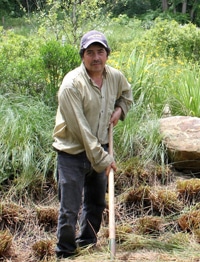
Beyond our facilities, the Stroud Center owns and maintains about 50 acres of grounds. And thanks to Salomon Romero and Javier Tinoco, woodlot technicians since 1992 and 1994, the forested areas, meadows, gardens, and lawns are in fine shape. Romero and Tinoco have been instrumental in maintaining the outdoor experimental areas and restoration plantings.
Since 2000, the Stroud Center has had funding from the National Science Foundation’s Long-Term Research in Experimental Biology (LTREB) program. The LTREB project at the Stroud Center is focused on understanding differences in stream ecology between open meadow and forested stream reaches, and the study of changes to meadow reaches as they recover to forest after riparian restoration. To achieve this, the Stroud Center needs to maintain a meadow reach and also manage the exotic invasive species that often invade our streambanks and forests.
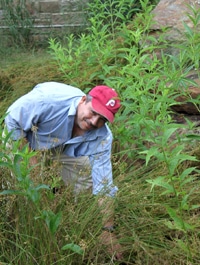
If you haven’t seen our campus lately, you should come for a visit. Tinoco and Romero have been busy around campus, and the grounds are now filled with rain gardens, a green roof, and native tree and shrub plantings that help manage stormwater runoff from our buildings and parking areas. Although the landscape was designed to minimize maintenance, gardens are never maintenance-free.
But Tinoco and Romero are much more than woodlot technicians. Especially during the cold season, both assist with facility maintenance and repair and have recently been demolition experts, painters, and carpet installers, as the Stroud Center refurbishes space in its older building.

Last but not least is Tonya Prigg. Since 1997, she has meticulously provided housekeeping services. Prigg does it all: windows, floors, dusting, recycling and waste removal, event cleanups, and laundry services. She has also had to increase her workload, as the Moorhead Environmental Complex has added about 16,500 square feet to our now nearly 43,000 square feet of indoor space. That includes a 1720s cabin (which serves as overnight guest accommodation for visiting colleagues), an 1800s restored barn (now our Ruth Patrick Library), a Quaker-style meetinghouse, and numerous labs, offices, and classrooms. As we have transitioned to more sustainable choices, Prigg continues to work with housekeeping suppliers to ensure that our choices in cleaning chemicals are environmentally safe, our paper products are derived from recycled materials, and our soaps are biodegradable and safe for our water and the organisms living in the water.
The Stroud Center thanks this team for their hard work and dedication.
In the News
Stream and Buffer Ecology Workshop Spread Enthusiasm for Restoration Work
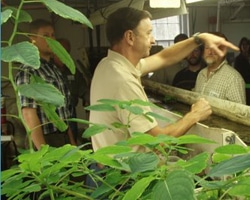
Robert “Bobby” Whitescarver attended a Stream and Buffer Ecology Workshop at Stroud Water Research Center and wrote about his experience on his blog. A retired field conservationist with the U.S. Department of Agriculture’s Natural Resources Conservation Service and now a consultant, Whitescarver is enthusiastic about stream restoration and conservation. His recent visit to the Stroud Center and time spent with Director Bern Sweeney, Ph.D., left him “refueled”: “Metaphorically speaking, I went to the riparian buffer oracle, asked what the answer to life was, and he said, ‘Keep planting native trees along the streams.’” Read Whitescarver’s blog post
Shannon Wehinger, director of communications for the Pennsylvania Association of Conservation Districts, also attended the Stroud Center’s Stream and Buffer Ecology Workshop. She hopes to work with the Stroud Center to identify future educational opportunities for district staff.
Stroud Center and Others Receive Process From Willowdale Steeplechase
Stroud Water Research Center was one of several organizations honored with proceeds from the Willowdale Steeplechase. This year, $55,000 was donated to local charities.
Stroud Scientists and Educators Present
Our scientists and educators engage in both scientific and public forums to share their findings, increase awareness, and create a public dialogue centered on the protection, preservation, and restoration of watersheds everywhere. The following highlights recent presentations.
Sharing the Value of Buffers and Bugs
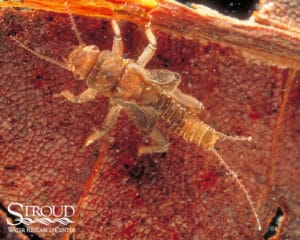
Stroud Water Research Center recently hosted two Stream and Buffer Ecology Workshops (one in May and another in June) sponsored by the Stroud Center and the Chesapeake Bay Foundation (CBF). Matt Ehrhart, Dave Wise, and Bernard Sweeney were on site to speak about the Stroud Center’s research findings that prove the value of riparian buffers in ensuring stream health. Lamonte Garber, agricultural manager for CBF, also spoke.
Attendees included professionals representing multiple agencies and organizations seeking to learn more about planting streamside forests. Since 1996 the Stroud Center has extended this training to over 1,000 conservation professionals.
Also in June, Sweeney discussed the importance of riparian buffers with state and federal employees as part of a workshop sponsored by the Pa. Dept. of Conservation and Natural Resources and CBF.
While buffers contribute to better water quality, macroinvertebrates can be used to monitor water quality. On June 10 at the University of New Mexico, Sweeney gave a lecture on new and novel approaches for using macroinvertebrates to assess water quality issues in stream ecosystems.
STROUD CENTER SCIENTISTS SHARE KNOWLEDGE WITH INTERNATIONAL LEADERS
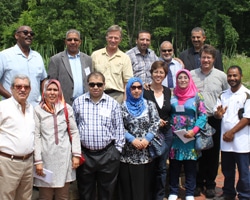
On June 27, international leaders in water management and associated fields spent the day at Stroud Water Research Center. Since 2011, the Stroud Center has hosted participants in the International Visitor Leadership Program (IVLP). The U.S. Department of State’s professional exchange program is designed to build mutual understanding between the U.S. and other nations through carefully designed visits to the U.S. for current and emerging foreign leaders.
It’s a unique opportunity for Center scientists to share their knowledge with key leaders from around the globe. In doing so, Stroud Water Research Center is building a better understanding of freshwater streams and rivers and helping participants make informed decisions relating to water quality issues in their respective countries.
Director Bern Sweeney, Ph.D., Assistant Director Dave Arscott, Ph.D., and Senior Research Scientist Lou Kaplan, Ph.D., led participants through a series of presentations on topics ranging from protecting headwaters to sensor network development in the Christina River basin. Kaplan also led a campus-wide tour. Visitors saw firsthand the cutting-edge facilities that enable Center scientists to conduct groundbreaking research and learned how the Moorhead Environmental Complex manages water.
Strouds Host Maine Outreach Event
On the evening of July 10, Bern Sweeney and Dave Arscott spoke to guests in the home of Mayra and Steve Stroud in Northeast Harbor, Maine. Sponsored exclusively by Wilmington Trust, “Advancing Knowledge of Fresh Water” highlighted the Stroud Center’s freshwater research, education, and watershed restoration and covered topics such as innovative technologies to address many of the issues facing water quality in our nation’s streams and rivers.
Summer Education Efforts in Full Swing
Education and public outreach are important components of the Stroud Center’s goal to ensure water quality and availability. Center educator Christina Medved has been helping to lead the charge. In June, she gave a presentation on the Leaf Pack Experiment for the PA Association of Conservation Districts Environmental Education Conference in Harrisburg, Pa. In July, she gave a three-hour “Streams Within a Watershed Context” workshop at Kean University. The workshop was offered as part of a weeklong intensive course for teachers offered through the New Jersey Council for the Humanities.
Medved authored published work as well. “Using Slimy Leaves for Stream Water Quality Assessment: The Leaf Pack Experiment” was featured in the July issue of the American Water Resources Association’s Water Resources IMPACT journal.
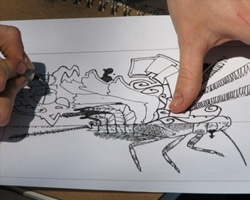
The Delaware Museum of Natural History published some Center staff photos as part of their exhibit “Water’s Extreme Journey,” on display now through September 2; Medved provided text on streams, explaining why they are important and how they fit into the big picture of estuaries and oceans.
Vivian Williams, the Stroud Center’s education programs manager and program design specialist, has also been busy thanks to program sponsorship from Point Lookout Farmlife and Water Preserve Foundation. In early June, Williams led participants in a Sustainability School “Letterboxing and Tree ID” workshop, and later that same month, she combined the science of aquatic life with creative expression for another Sustainability School workshop, “Paddling the Brandywine,” offered in partnership with The Land Conservancy of Southern Chester County. Youth programs in July included “Investigating Macroinvertebrates” at Point Lookout, offered in partnership with the Delaware Center for Horticulture, and “Origami Frog in Stream,” offered as part of the Brandywine Naturalist Summer Camp at the Hagley Museum.



